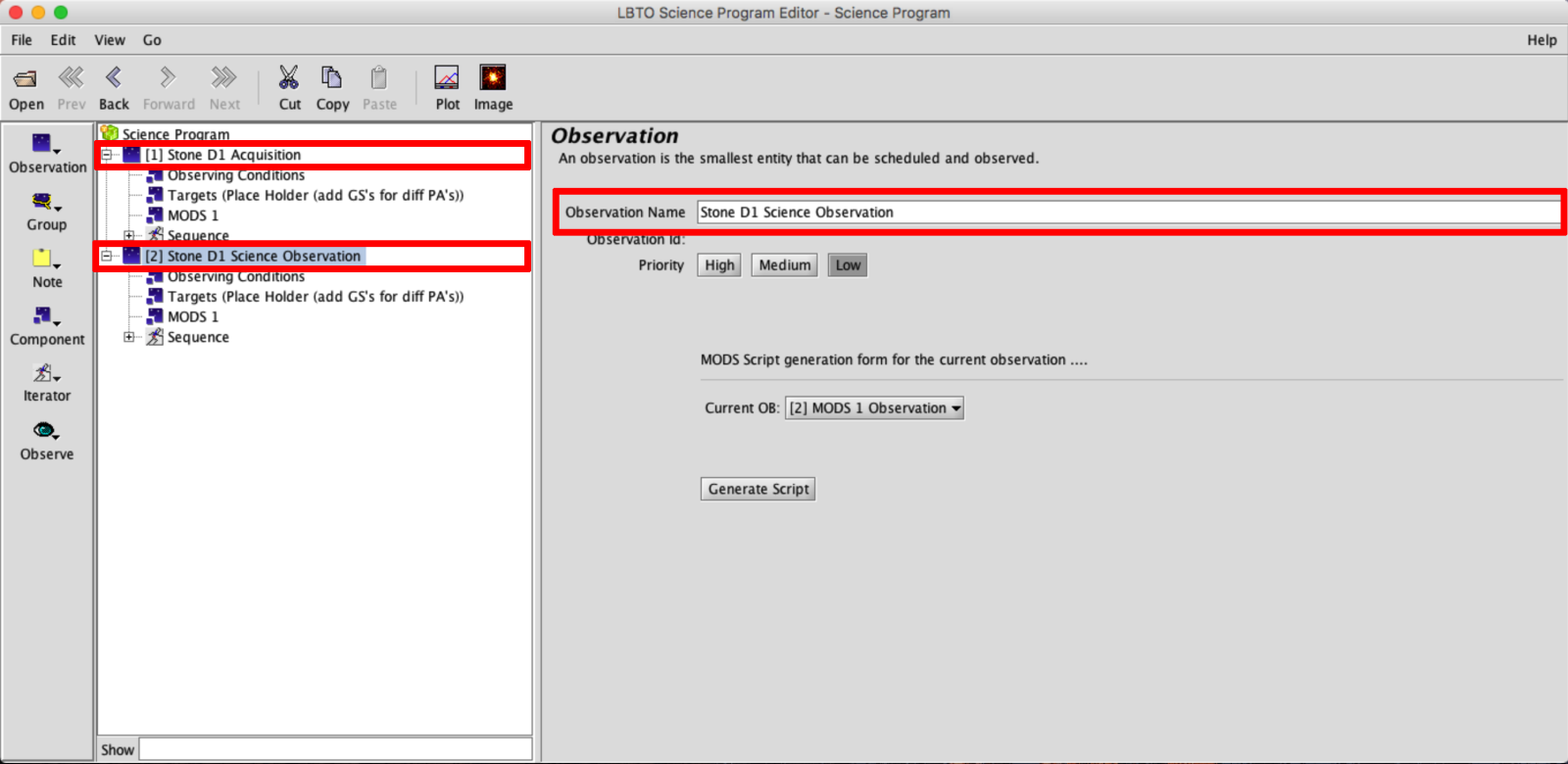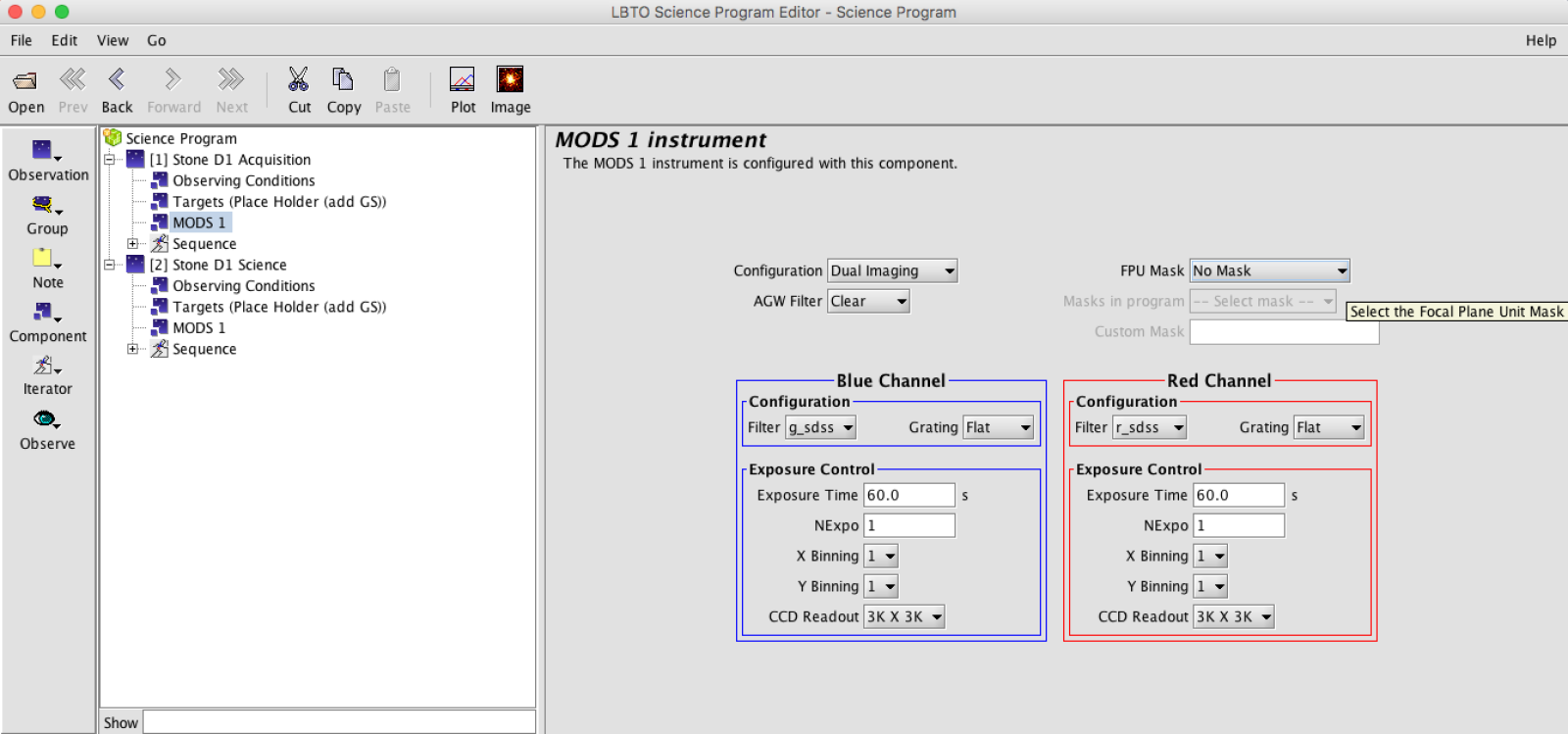3: Multi-Slit Example
Example 3: Setting up Multi-Slit Science Observations
Multi-slit observations use the same templates as the long-slit observation. The difference comes when the MMS file is loaded, and with how the target information is loaded.
Highlight the Acquisition and Science Template for the desired type of observation and then click COPY in the Main Toolbar. For most Multi-Slit observations, use the
Back in the *empty* Science Program PASTE the observations by hitting PASTE in the Main Toolbar
Tailor the Template with your Observation details following the tree of the Observation in the Template:
- Observation Element: For both the Acquisition and Science Observations, change the Observation Name from the generic template name to something descriptive. Make sure to distinguish between the Acquisition and Science portions of the observations. This can help observers easily identify observations in the OT Science Program if multiple observations are provided.

- Observing Condition Element: Complete the information in the Observation Conditions Element by selecting the nodes that roughly align with what was requested in your TAC proposal. These conditions are not guaranteed conditions and are not passed to the script in any way.
Pro Tip 2: Since Observing conditions information is not passed along in the Observing Scripts, it is important to not only pass along your complete scripts but this complete OT Program as well to LBTO and the Partner Coordinator. Details for exporting the OT are available here.
Copy and paste the Observing Conditions Element between the Acquisition and Science Observations for consistency. To do this, with the Observing Conditions Element selected in the Acquisition Observation select COPY in the Main Toolbar. Select the Observation Element of the complimentary Science MODS observation and select PASTE from the Main Toolbar. - Skip the Target Element in the Science Program Tree. The target information will be populated by the mms file.
- MODS Instrument Element : This element will define the initial configuration of the instrument. Set the Configuration first: Dual Grating, Dual Prism, Red Grating, Red Prism, Blue Grating, or Blue Prism.
 The Disperser, CCD Readout, and order sorting filters will auto populate (for example, any grating observation the CCD Readout is set to 8Kx3K, and for prism the CCD Readout is 4Kx3K).Then set the mask in the FPU Mask drop down menu to Custom. Load the MMS File for the Custom mask by clicking the Load MMS File and selecting your MMS file in the dialog box that appears.
The Disperser, CCD Readout, and order sorting filters will auto populate (for example, any grating observation the CCD Readout is set to 8Kx3K, and for prism the CCD Readout is 4Kx3K).Then set the mask in the FPU Mask drop down menu to Custom. Load the MMS File for the Custom mask by clicking the Load MMS File and selecting your MMS file in the dialog box that appears.



Load the mask into both the Acquisition and Science observations, or copy the Instrument and target element from the Acquisition to the Science Observation.
If observing a particularly bright guide star, one may wish to insert a filter into the AGW. In the Camera element(s) exposure time, number of exposures, and binning for the initial instrument configuration filling in the fields and nodes. These fields can be adjusted for exposures beyond the first exposure in the sequence tab. Set this Element in both the Acquisition and Science Observation. Make sure that the mask used in the Acquisition is the same as that used in the Science Observation.
- Sequence Element:
- Acquisition Sequence: The MODS multi-slit (and Long-slit) Acquisition Sequence is composed of 3 components: Mask Image, Source Image, and lastly a confirmation Mask + Source Image. The Sequence is comprised of a MODS Sequence Iterator and Observe Type. Select the MODS Sequence Iterator. Within this Element you will see the 3 exposures for the Slit Image, Source Image, and lastly a confirmation Slit + Source Image.

For good housekeeping, change the mask for the Slit + Source Image to match the mask you set in the MODS Iterator tab. What ever mask is set at the top of the script (set in the Instrument Iterator and shown as the Slit image mask) will be set for the entire script, but it is best to be consistent regardless. There should be no need to adjust anything else. Exposure time are typically set in the Instrument Element, and one would like to use the same exposure time throughout the sequence, although if one desires any changes this is where it can be done. The Observe Type will be set to Acquisition. - Science Sequence: The MODS multi-slit sequence is composed of 1 to 2 iterators: possibly an MODS Offset Iterator, and Observe Type. With MODS, Offsets are not commonly performed so the presence of the Offset Iterator will depend on the template selected and desired science. For the “MODS# Long-slit Dithering Along Slit Templates”, there will be an offset iterator nested in the Sequence. The Observe Type will be to Science or Standard depending on the science goals of the observation.
- Acquisition Sequence: The MODS multi-slit (and Long-slit) Acquisition Sequence is composed of 3 components: Mask Image, Source Image, and lastly a confirmation Mask + Source Image. The Sequence is comprised of a MODS Sequence Iterator and Observe Type. Select the MODS Sequence Iterator. Within this Element you will see the 3 exposures for the Slit Image, Source Image, and lastly a confirmation Slit + Source Image.
Generate both the acquisition and science observation scripts. Script generation is discussed here .



